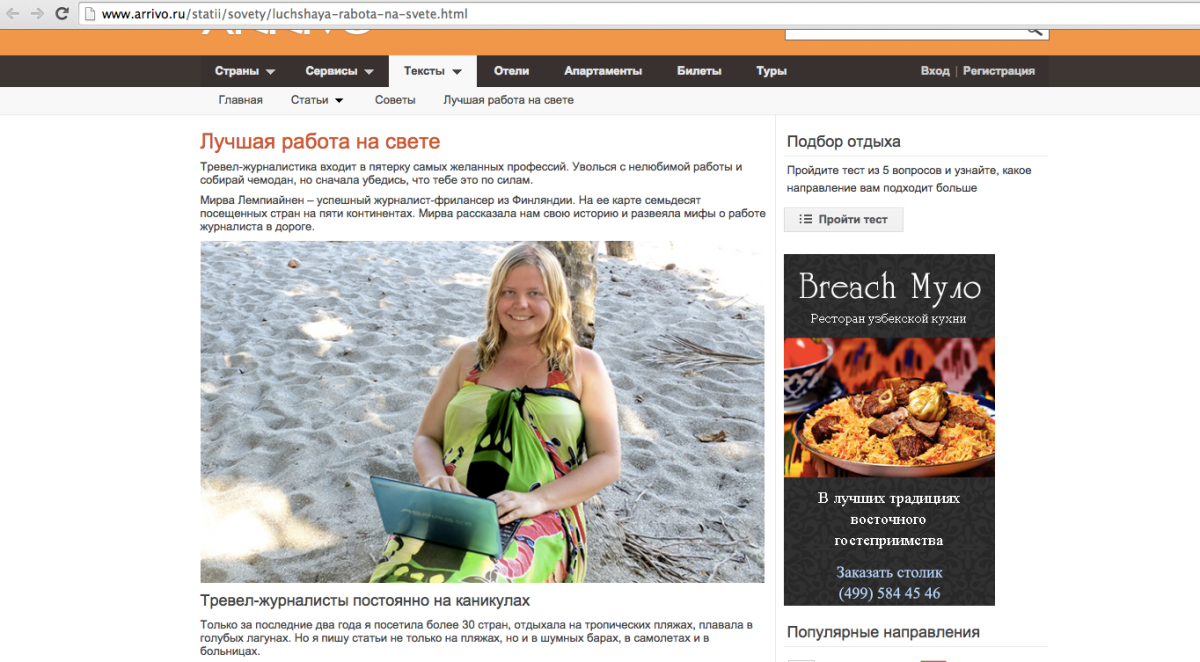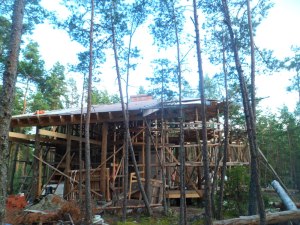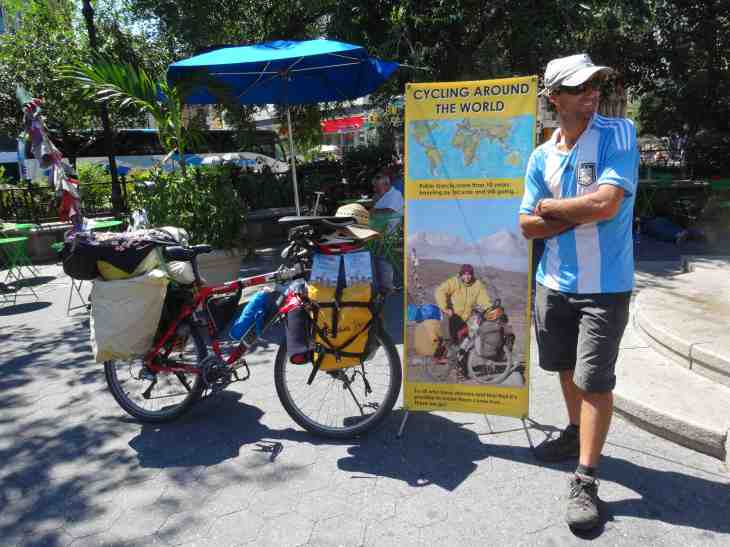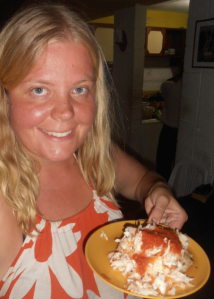Happy New Year everyone! I know, I know, I’m a little late to the game but this is my first post in 2014. Yikes! Here’s a picture from the wild NYE celebrations I took part in Tel Aviv. That place can party! My friend and I danced at this underground club The Cat and Dog until 7 a.m., but turned down all the offers of drugs and bathroom hook-ups. 😛

What a crazy year it has been so far, and we are only in mid-February. Over the last seven weeks I’ve taken nine flights and set foot on eight countries on three continents. I’ve gone from dark wintery Finland to spring-like Israel, made pit stops in Istanbul and Berlin, and taken a painful 18-hour train ride through Bulgaria. In late January I got into a car crash with a motorcycle in the Dominican Republic and yet danced bachata afterward for a week in a beach festival. I suffered through a few New York snowstorms in February but escaped to Brazil just before the 14th one. I’m now under the hot Brazilian sun in Rio de Janeiro and loving it! And this was supposed to be my year of taking it easy and not traveling as much… only a few months ago I was happy to be living a somewhat stable life in NYC and was trying to convince more digital nomads to move there.
But alas, such is a traveler’s life. It changes in a New York minute. 🙂
So now that I’ve suddenly found myself back in the only Portuguese-speaking country on the South American continent, it might be a good time to share some of my thoughts about this land that’s known for samba, sun, beaches, favela shantytowns (one of which I’m currently staying in – and the view is lovely!) and of course the impending World Cup. These oddities appeared in my old blog, written in 2008 during my first trip to Brazil, but I’ve found that they still hold true.

10 WEIRD THINGS TO KNOW ABOUT BRAZIL
1) Brazilians LOOOOOOVE meat!! There’s always a barbeque party (or a churrascu, as it’s called in Portuguese) coming up, and nope, they do not grill any tofu or tomatoes or tofu sausages here. It’s all about meat: steaks, ribs, chicken wings, chicken hearts (yep!), sausages…. maybe a bit of fish, too.

2) Salt is DEFINITELY a favorite among the Brazilians…. they use so much of it on everything that I’m surprised they aren’t having tons of heart attacks (or maybe they are… not sure about the stats..).
3) This is definitely the promised land of all-you-can-eat buffets, and “food by the kilo” buffets (where you pay according to the weight of your plate). They’ve even got this cool thing called “rodizio,” a buffet that comes to you! All you need to do is sit down at a table, and the meat/pizza/sushi just appears on your plate. The waiters bring the food around every few minutes, and you can choose what you want and have as much as you’d like. Yummy!
4) Brazilian houses (the upper-class ones anyway) tend to have several toilets. One for each room is not uncommon, I hear. Therefore a medium-size house can even have six toilets. Wow! No more waiting for your turn outside the door 🙂
5) Many of the bathrooms have a bidet bowl next to the toilet. It kind of looks like a cross between a sink and a men’s urinal. No one seems to know what to do with it. It’s just tradition to have one. I guess previously it was used for washing yourself up, but nowadays it seems to be just an expensive laundry basket!
6) Brazilians love all things made of manioc/yucca/cassava, the traditional root that tastes slightly like potato. Mandioca is eaten in soups, as mashed (like potato), as fried (like french fries) and even used as flour to dip your meat in… and probably in many more ways.
7) Brazilians also love their national booze, cachaça aka pinga, the main ingredient of caipirinhas. They think it’s the greatest thing ever invented. Taste-wise it’s not my favorite, but I gotta say it’s not the worst beach drink… (here as a mango version).

8) Brazil is definitely NOT the right place for someone who has bacteria phobia! The locals love to share everything with their friends: beer, coke, water, pinga, not to mention food. If you buy a tapioca (sort of like a taco) or a sweet corn cob, you’ll need to offer bites to all of your pals. So you may even be sharing your drink or food with up to 10 people. But hey, what doesn’t kill you, makes you stronger! 😉 The Brazilian immune systems surely must be strong from all this sharing.
9) It’s fairly easy to become a true Paulista (FYI, a Paulista is a person from Sao Paulo. Carioca = Rio resident). All you need to do is spot a local “celebrity” called Fofäo on the city streets (well, more like a local loonie bin). Hahaa. 🙂 Fofäo is a scary-looking man who has injected tons of silicone into his cheeks… he got his nickname from a cartoon character who looks the same way.

Why this guy has done that to himself, nobody knows. My Sao Paulo friends said he is a transvestite who was trying to be transformed into a woman. When that failed, he just became a weird-looking man who had done tons of operations to himself. Other people are scared of him, others just feel sorry… some say he can be violent too, so better keep your distance I guess. Fofäo works odd jobs around the city of Sao Paulo and can be spotted here and there by any lucky people walking around town… or unlucky, as he looks very scary! Legend says you can have a heart attack if you see him in the dark. As for me, I saw him twice during my 2008 visit to Sao Paulo. Once he had crazy make up on his face, neon colors all over. I guess that was to promote some flyers he was distributing. Scaaaaary….. I walked past him stiff as a stick… So yeah, you would think that in a city with 16 million people you wouldn’t see the same person twice but apparently you cannot avoid seeing Fofäo. Unless you are a Carioca for life… 🙂
10) Brazil has a reputation of being a somewhat dangerous place. However, the main thing that reminds you of the unsafe nature of the country are Brazilians themselves and the way they guard their possessions (those that have them, naturally). Most of my friends here have high fences around their houses, alarm systems, a scary barking dog in the backyard and some even have a paid guard patrolling their street. When going out in the city, my friends park their cars in guarded parking garages, as the risk of the car being robbed is supposedly high. Apartment buildings often have a guard downstairs who checks who is coming in and out. Sometimes my friends will ask me to walk fast as “this is not a safe area.” But I’ve seen a lot of proof that Brazil is not as dangerous of a place than what the locals make it out to be. For example, it’s customary here that if you are left without a seat in the bus, someone who has a seat will hold your purse so that you have two free hands to hang on to the strap rather than just one. WOOOOOW! I wouldn’t trust my purse to a stranger even in Finland! But here people don’t even think twice about it. How cute! 🙂

So yeah, Brazil is great and well worth a visit even outside of the World Cup! (For which I’m not sticking around, by the way… I’m not a fan of sports crowds.) People here are really friendly and even if you just met them, they will probably invite you to stay in their house for a few days, or to come for a barbeque. And they always have a friend in another city, and “you can call them when you are there and they will help you out with everything!” 🙂
0.000000
0.000000




























